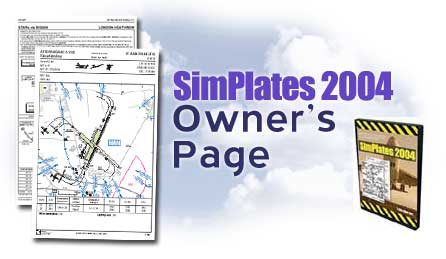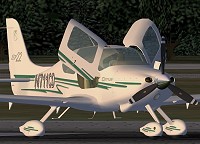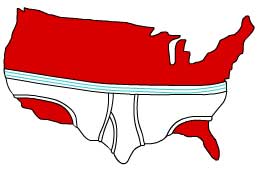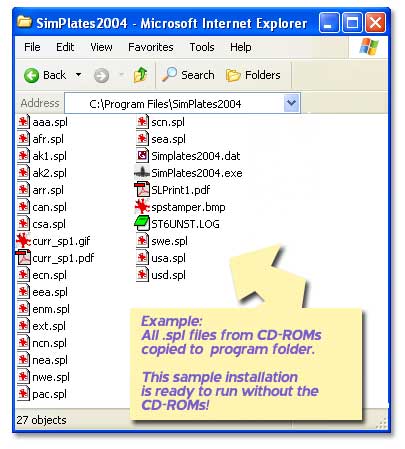|
|
Welcome to the SimPlates user page! This is your one-stop reference point for questions, technical support, and other issues.
Don't see your question answered here? Try the FAQ on the main SimPlates 2004 page. Haven't purchased SimPlates 2004 yet? See the main SimPlates 2004 Page. Patches and upgrades are available from the on-CD version! While there are no major issues on the CD-ROM versions, Click here to get the latest tweaks and upgrades.
Real-World Use Can I use SimPlates data for real world flight? The makers of this product do not endorse it or the data contained / produced therein for use for real-world flight and will not be held responsible if you do so. The product is labelled NOT FOR NAVIGATION and is intended for on-the-ground-where-you-can't-run-into-anything educational and flight-simulator use only. The data is actual FAA/NIMA data, but we don't want to certify it as it is OK for flight - there may have been errors in transcription or other errors that we don't know about. For those of you who want to ignore the above and indeed consider using the plates for real-world flight, here are some reminders. In the below, where I refer to "charts", I refer to all data that is produced by SimPlates, including airport/facility information, NAVAID information, approach plates, airport diagrams, and so forth. for FAA/US VFR Pilots: Some interpretations of the Federal Aviation Regulations state that there is in many circumstances NO requirement for a pilot to carry any charts, much less current ones. By that interpretation, you could use this comedy picture of the USA wearing briefs to navigate:
However, the fact of the matter is that if you do something dangerous, deadly, or illegal because of doing something silly like that (or using material that clearly says "NOT FOR NAVIGATION" on it!), you will get nailed by the FAA under the general provisions that say that the pilot-in-command must make himself/herself with all available information before a flight. for FAA/US IFR Pilots: The Federal Aviation Regulations are clear: for IFR flight in the USA, you need to have "current" data (including approach plates). The question, then, is "what is current data?" Some pilots claim that if nothing on an approach plate has changed in years, then it's still "current data" and thus still valid for navigation, even if the chart is past its nominal expiration date. The thing is though - how will you know if your plate still has the unchanged data unless you have a new one? Really - just go and buy some proper approach plates and don't get yourself into this mess. for non-USA Pilots: We have no idea, but common sense says "probably not." Check with your local aviation authority.
Technical Issues Running without CD-ROM To run without the CD-ROMs, you need to copy the .spl files from the CD-ROMs into the program directory on your hard drive. So, if your program is installed into c:\program files\sp2k4, then copy all of the .spl files into this folder. Note 1: this takes a fair bit of hard drive space. Note 2: this is unsupported, and no technical support will be provided for this. If you're not sure how to do this, please consult your local computer guru and show him/her these instructions.
I double click on a plate and nothing happens! All of SimPlates' approach plates are launched in Adobe Acrobat / Acrobat Viewer. You must have an appropriate viewer installed - if you don't, click here to get one. If you have an appropriate viewer installed, then the problem might be more complex. I've noticed that Acrobat Reader tends to "hang" on certain systems where certain internet security software, like Norton Internet Security, are installed. The usual effect of this is that Reader will launch fine for the first one or two plates, but then not appear to launch thereafter. Unfortunately, this is a bug with either Acrobat or the security software - the only workaround that I've seen is to go into task manager (ctrl-alt-delete) and shut down acrobat.exe and then when you launch another pdf document (approach plate), Acrobat will restart normally. Also, if you click too fast sometimes, you may get a "document could not be loaded" message. Solution? Don't click so fast!
Plate X is askew, cut off, or bad quality Unfortunately, with 18,000 plates, a small percentage of scans is bound to be off. We apologize if this causes you major inconvenience or if it just happens to be your favorite approach. In general, the plates of SP2K4 are of a high scan quality, though you might notice in the program that the output for some plates is differnent looking than that of others - this is because we are using two data sources which compiled the data differently.
It shows a plate that says "this plate could not be loaded." If this happens for the odd plate here and there, then, we apologize - that plate is not available. If this happens consistently with every plate you try, then something is up. Try reading the sections of this document with regards to setting up your data directory, and then contacting us for support if that doesn't work. Re-installing the software from the original CD-ROMs might be a good idea, too.
Content Questions How many plates are provided by SimPlates? Just over 18,000. About 3/4 of these are USA plates, and the rest are for approaches and facilities worldwide. PlatePacks add even more.
Do you have all US Approches? Just about. There may be a few that aren't in there, but it's safe to say that SimPlates covers 99%+ of USA instrument approaches.
Do you have all Worldwide Approaches? (incidentally - sorry for calling it "US vs Worldwide" - that's a bit US-centric, but it's appropriate for discussion here). Unfortunately not. SimPlates covers many / most major world airports, but is by no means comprehensive as far as world airports go. Click here for a list of included world airports.
Why don't you have airport USA Airport X? If you're talking about an airport in the US - please check again. Airports are sometimes listed differently than you might expect. For example, the airport currently known as "Monmouth Executive" in New Jersey has, all within the last few years, been known as Allaire, Bellmar, etc. due to changes of ownership. Knowing the right airport ID helps, but those change too. The actual data provided by SimPlates is consistent in time with the approach plates - that is, MOSTLY around Oct/Nov 2003. That said, there may be a US airport or two that we simply don't have for whatever reason. Sorry. Also - remember that only airports with instrument approaches will have instrument approach plates! Many small airports (including virtually all grass airports) don't have instrument approaches, and hence there are no plates. SimPlates does provide airport data for all listed US airports, including those without plates.
Why don't you have airport non-USA Airport X? Outside of the USA. SimPlates was produced from US government data. As such, we can only provide what they produce. We wish just as much as you that the governments of, say, Europe would place their publications under as liberal a copyright as they are in the USA. Fortunately, this includes most major world airports. Unfortunately, this often does not include secondary civil airports. Click here for a list of airports that have plates in SP2K4. PlatePacks add even more airports!
Why don't you have SIDs and STARs? We do, actually. Thousands of them in SimPlates. Except that they're not officially called SIDs and STARs anymore, but rather Departure Procedures and Arrival Procedures. If you see "SID" or "STAR" written on some plates still, it's basically a remnant that the plate issuing agency hasn't gotten around to fixing yet.
Why are US Arrivals listed seperately? Why are there no US Arrivals Plates? SimPlates 2004 does have all US Arrival plates. To get these, click on "click here for FAA Arrivals" in the IFR Plates screen. Theses are listed seperately because the FAA lists them by geographic region, not airport, so they wouldn't fit into the structure of the rest of the plate database. For example, the GOLDEN GATE FOUR Arrival is used for both San Fransisco and San Jose airports. Some arrivals are used by handfuls of airports, including ones not listed in on the arrival plates themselves, such as in the case of an IFR aircraft in VMC (Visual Meteorological Conditions) arriving to an airport without a listed IAP (Instrument Approach Procedure).
There are some duplicates ... There may well be a small number. This is primarily due to a few cases where FAA and NIMA effectively publish the same plates. We keep both in there a) in order that we don't accidentally delete something useful (in case two similar plates vary slightly) b) to allow you to print plates in a consistent format.
Why is the NAVAID data separated by US/FAA and Worldwide/NIMA? The data comes from two different databases and it would be counterproductive to try to merge them into the same format. Note: the NIMA database also contains many US NAVAIDs. The FAA and NIMA databases vary somewhat on exactly what data they provide.
There are typos - The data that is presented comes from US government databases as-is. There are typos in those databases. We've spent about 100 hours just cleaning up the database already and fixing typos, but several doubtlessly remain. To put things in perspective - NIMA maintains a master "country" list where basic, basic details of each country are kept (like name and code). We found not less than 15 countries' names were spelled incorrectly in this "master" list.
About SimPlates + Thanks SimPlates is was designed and implemented by Adrian C. of Dauntless Software. Adrian is an FAA-certified flight/instrument/multiengine instructor with about 3300 hours of flying experience. He's also a big-time simulator enthusiast who has developed several free aircraft for various versions of flight simulator. Currently, Adrian is a poor graduate student working on a PhD, and in the off chance that SimPlates makes enough money to cover its costs, any overage will go solely towards helping him pay his significant tuition debt. Needless to say, the time spent working on SimPlates set his research back several months :). Special thanks to the sim enthusiasts at the FS2004.com forums who contributed the screenshots which formed the basis for SimPlates background screens. Superb work, guys! If you're interested in more great looking flight simulator screenshots, please click here. Thanks also to the good folks at the FAA and NIMA (National Imagery and Mapping Agency) for assisting with the provision of the reams of data that went into SimPlates.
If you need to contact the author(s) of SimPlates, please do it via this contact page Don't see your question answered here? Try the FAQ on the main simplates page.
|



